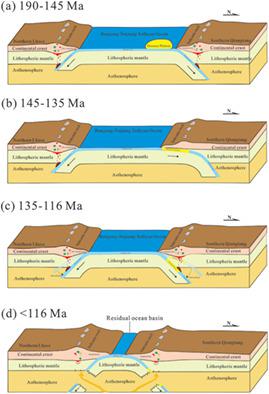当前位置:
X-MOL 学术
›
Geolog. J.
›
论文详情
Our official English website, www.x-mol.net, welcomes your
feedback! (Note: you will need to create a separate account there.)
Mesozoic multiple magmatic events in Bangor area: Constraints on the tectonic evolution of Bangong–Nujiang Tethys Ocean
Geological Journal ( IF 1.4 ) Pub Date : 2021-06-13 , DOI: 10.1002/gj.4166 Weiming Xie 1 , Yinbiao Peng 1 , Pei Lv 1 , Xiangyu Gao 1 , Shengyao Yu 1, 2, 3
Geological Journal ( IF 1.4 ) Pub Date : 2021-06-13 , DOI: 10.1002/gj.4166 Weiming Xie 1 , Yinbiao Peng 1 , Pei Lv 1 , Xiangyu Gao 1 , Shengyao Yu 1, 2, 3
Affiliation

|
The Bangor area is located in the middle part of the Bangong–Nujiang Suture Zone (BNSZ), where a large number of Middle Jurassic-Early Cretaceous magmatic rocks are exposed, and is a key area for studying the tectonic evolution of the Bangong–Nujiang Tethys Ocean (BNO). However, the arc magmatic system triggered by the southward subduction of the BNO has not been systematically identified in the northern margin of the Lhasa Terrane, and the timing of initial subduction and closure is still controversial. In this study, four granite, two amphibolite, and one gabbro samples from the Bangor area yield two clusters intrusive ages of 162–168 Ma and 121–133 Ma. The Stages I and II granites show whole-rock geochemistry similar to those of continent arc magmatism, characterized by enrichment in large ionic lithophile elements (LILEs; e.g., Th, Rb, K) and depletion in high field strength elements (HFSEs; e.g., Nb, Ta, P, Ti). The Stage I magmatic rocks consist of granodiorite, amphibolite, and gabbro and have similar zircon εHf(t) values of −10.1 to −3.5, which may be formed by partial melting of enriched mantle wedge related to the southward subduction of the BNO. The Stage II highly differentiated I-type granites show positive zircon εHf(t) values of +1.5 to +9.9, which are considered the product of highly differentiated processes via the mixed magma derived from depleted mantle and lower crustal rocks. The Stage II I-type granites show negative zircon εHf(t) values of −9.2 to −0.7, which are derived from a mixed magma source generated by partial melting of lower crust and enriched lithospheric mantle. On the basis of data from this study and previous research studies, a four-stage tectonic evolutionary model of the Bangong–Nujiang Tethys Ocean is constructed: Stage 1 (190–145 Ma), the northward and southward subduction of BNO formed a series of arc magmatism; Stage 2 (145–135 Ma), a magmatism lull occurred on the north side due to the subduction effect of the ocean plateau, while the southward subduction still continued; Stage 3 (135–116 Ma), the roll-back of subducted slab enhanced the magmatism in this stage; and Stage 4 (<116 Ma), the closure of BNO lead to the formation of syn-collisional magmatism.
中文翻译:

班戈地区中生代多次岩浆活动:对班公-怒江特提斯洋构造演化的制约
班戈地区位于班公—怒江缝合带(BNSZ)中部,出露大量中侏罗世—早白垩世岩浆岩,是研究班公—怒江构造演化的重点区域特提斯海洋 (BNO)。然而,拉萨地块北缘由BNO向南俯冲引发的弧形岩浆系统尚未被系统识别,初始俯冲和闭合时间尚存争议。在这项研究中,来自班戈地区的四块花岗岩、两块角闪岩和一块辉长岩样品产生了两个侵入年龄为 162-168 Ma 和 121-133 Ma 的簇。I 期和 II 期花岗岩显示出与大陆弧岩浆作用相似的全岩地球化学特征,其特征是富含大离子亲石元素(LILEs;例如,Th、Rb、K) 和高场强元素(HFSE;例如,Nb、Ta、P、Ti)的损耗。Ⅰ期岩浆岩由花岗闪长岩、角闪岩和辉长岩组成,具有相似的锆石ε Hf ( t ) 值为-10.1 至-3.5,可能是与BNO 向南俯冲有关的富集地幔楔部分熔融形成的。第二阶段高度分化的 I 型花岗岩显示正的锆石ε Hf ( t ) 值为 +1.5 至 +9.9,这被认为是通过来自耗尽地幔和下地壳岩石的混合岩浆高度分化过程的产物。II 期 I 型花岗岩显示负锆石ε Hf ( t) 值 -9.2 至 -0.7,来自下地壳和富集岩石圈地幔部分熔融产生的混合岩浆源。在本研究资料和前人研究资料的基础上,构建班公-怒江特提斯洋四期构造演化模型:第一期(190-145 Ma),BNO向北和向南俯冲形成一系列弧岩浆作用;第2阶段(145-135 Ma),由于大洋高原的俯冲作用,北侧出现岩浆活动平息,而南下俯冲仍在继续;第三阶段(135-116 Ma),俯冲板片的回滚增强了该阶段的岩浆作用;第四阶段(<116 Ma),BNO 的闭合导致同碰撞岩浆作用的形成。
更新日期:2021-06-13
中文翻译:

班戈地区中生代多次岩浆活动:对班公-怒江特提斯洋构造演化的制约
班戈地区位于班公—怒江缝合带(BNSZ)中部,出露大量中侏罗世—早白垩世岩浆岩,是研究班公—怒江构造演化的重点区域特提斯海洋 (BNO)。然而,拉萨地块北缘由BNO向南俯冲引发的弧形岩浆系统尚未被系统识别,初始俯冲和闭合时间尚存争议。在这项研究中,来自班戈地区的四块花岗岩、两块角闪岩和一块辉长岩样品产生了两个侵入年龄为 162-168 Ma 和 121-133 Ma 的簇。I 期和 II 期花岗岩显示出与大陆弧岩浆作用相似的全岩地球化学特征,其特征是富含大离子亲石元素(LILEs;例如,Th、Rb、K) 和高场强元素(HFSE;例如,Nb、Ta、P、Ti)的损耗。Ⅰ期岩浆岩由花岗闪长岩、角闪岩和辉长岩组成,具有相似的锆石ε Hf ( t ) 值为-10.1 至-3.5,可能是与BNO 向南俯冲有关的富集地幔楔部分熔融形成的。第二阶段高度分化的 I 型花岗岩显示正的锆石ε Hf ( t ) 值为 +1.5 至 +9.9,这被认为是通过来自耗尽地幔和下地壳岩石的混合岩浆高度分化过程的产物。II 期 I 型花岗岩显示负锆石ε Hf ( t) 值 -9.2 至 -0.7,来自下地壳和富集岩石圈地幔部分熔融产生的混合岩浆源。在本研究资料和前人研究资料的基础上,构建班公-怒江特提斯洋四期构造演化模型:第一期(190-145 Ma),BNO向北和向南俯冲形成一系列弧岩浆作用;第2阶段(145-135 Ma),由于大洋高原的俯冲作用,北侧出现岩浆活动平息,而南下俯冲仍在继续;第三阶段(135-116 Ma),俯冲板片的回滚增强了该阶段的岩浆作用;第四阶段(<116 Ma),BNO 的闭合导致同碰撞岩浆作用的形成。











































 京公网安备 11010802027423号
京公网安备 11010802027423号